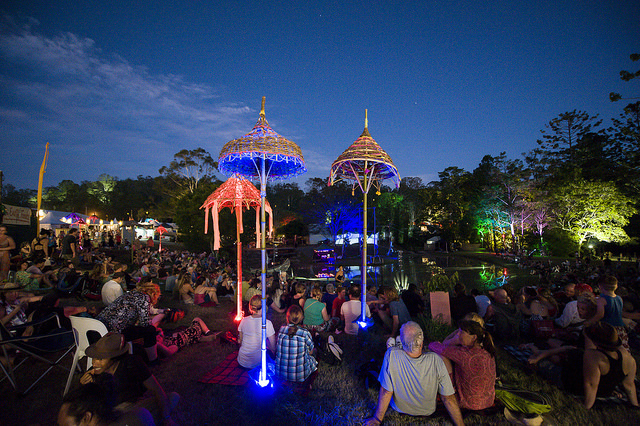
Synonymous with summer, music festivals welcome large numbers of live music aficionados making long treks to hear their favorite bands perform – as well as pour lots of money into the coffers of organizers.
Between 1999 and 2009, the North American concert industry saw profits jump by 40% as annual live music revenues increased from $1.5 billion to $4.6 billion. In 2017, Coachella became the first reoccurring music festival to gross more than $100 million. Communities that host such massive shindigs often get a large piece of the pie. In its first year of existence, the Firefly Music Festival in Delaware is projected to have pumped more than $12 million into the local economy.
Reducing waste left behind at festivals
However, music festivals often struggle to be environmentally-friendly. In the U.K., festivals cause 21,800 tons of carbon emissions per year. That figure doesn’t include attendees and artists’ journeys to such events, which could be another four times the above-mentioned number, according to Powerful Thinking, an organization that works with festivals to decrease their environmental footprint. Furthermore, British festivals produce 26,000 tons of waste annually and recycling rates barely exceed 32%.
Many festivals are taking numerous steps to reduce waste left behind. Lyndsey Harvey, the regional Public Relations manager of England’s Larmer Tree Festival, has expressed pride in her event’s recycling efforts.
“The setting at Larmer Tree Gardens is beautiful and we want to keep it that way,” she says. “So we work with our local council to ensure that all recyclable materials are collected and processed at the end of every festival.
“Any material that can’t be recycled is baled for waste energy production so nothing goes to landfill. We also encourage all of our workshop and carnival leaders to use as many recycled materials as possible and after the festival, all unclaimed lost property is donated to charity.”
Another festival experiencing success in increasing its recycling output is Scotland’s HebCeltfest. In 2013, it became one of the first festivals to launch a Recycle and Reward scheme in order to incentivize recycling. While the plan has encountered some difficulties, it has sparked a reduction of waste in landfill, according to one festival staff member.
HebCeltfest has also made further strides in reducing waste. The event has implemented the use of reusable ecocups, a decision the staff member says has been “popular not only with festival goers who appreciate why we implemented them in the first place” as well as the driving force behind the reduction of waste filling the site going to “literally zero overnight.”
Organizers at San Francisco’s Outside Lands Festival have devised another creative method for cutting down waste. Guests who bring their own water bottles to the event are allowed to fill up for free at water stations, which one year prevented more than 50,000 plastic water bottles from littering the ground.
But simply reducing waste isn’t the end goal for Lyndsey Harvey. The Larmer Tree Festival has taken advantage of its partnership with the Trussell Trust to benefit the larger community.
“With the Trussell Trust, we encourage guests to leave all their nonperishable food in special containers, which is then redistributed via Trussell Trust food banks,” Harvey says. “That means we can not only cut down on food waste but also help a fantastic food charity.”
Transportation is also a major environmental concern
The biggest challenge festival organizers face in trying to make their events more sustainable happens away from festival grounds. Transportation to and from the venues generally results in 80% of total emissions for festivals.
Convincing patrons to come via public transport has proven to be challenging for some festival organizers as most festivals are held in rural areas because festivals require immense amounts of space where temporary structures can be constructed easily. The selection of rural areas as festival settings essentially forces attendees to travel by car to such events. Not surprisingly, 66% of festival goers participating in one survey said the car was their preferred method of transportation.

This issue affects festivals worldwide. Woodford Folk Festival is one of Australia’s most popular music festivals, bringing in more than 132,000 attendees each year. Held in the hinterlands of the Sunshine Coast over the end of the year, the lack of public transport over that period presents a significant challenge for organizers. When asked if her festival has been able to turn attendees toward choosing a greener way of arriving on the premises, Woodford Folk Festival business development manager Corrina McGowan says, “Not really.”
“Bringing camping equipment on public transport is not practical,” McGowan adds. “However, our day trippers and more sharing vehicles has been improved but because public transport to our ‘out in the bush’ location is limited, our success generally is not something we can bark about.”
Harvey also laments the lack of public transport options. “Our location is right in the countryside, so public transport options are limited for us,” she says. “However, we have always encouraged our attendees to lift share as much as possible.”
Festival organizers have devised creative ways to reduce the ecological footprint of transportation. Pickathon, a festival held on the outskirts of Portland, Oregon, runs a free bicycle parking lot as well as a shuttle. Approximately 500 bicycles were parked in the lot in 2012 and festival organizers estimate a quarter of attendees used one of the two above-mentioned options. Meanwhile, while patrons at California’s Lightning in a Bottle who choose to drive to the festival solo must fork out $30 for parking (drivers in vehicles with more than one passenger are entitled to free parking), they can purchase carbon credits to offset their trek to the event.
England’s Shambhala Festival is also developing a greener way of transport to the event as an incentive for music lovers to come. According to its sustainability manager Henry Taylor, Shambala subsidizes coaches from several British cities – 20% of the festival’s ticket sales are set aside for coach travel.
“It comes at a cost,” Taylor says. “But we see it as a necessary step to limiting the overall impact of the festival.”
Furthermore, Shambhala has established partnerships with a car-sharing website and a cycling tour group that brings guests from Bristol and London. Organizers have also implemented a tier of ticketing for patrons arriving via bicycle.
Reducing the festival’s footprint
Community involvement can also push a music festival to incorporate more aspects of sustainability. The Woodford Folk Festival is a case in point as the event has invited attendees to “green” up the proceedings as part of its Forest Woodfordia.

“Our patrons sponsor trees and then pay for the privilege of coming back to plant them,” says McGowan of the project that has seen the planting of roughly 110,000 endemic rainforest trees and plants on festival grounds. “This project has had the wonderful outcome of giving ownership to our community, which wasn’t planned.”
The Finger Lakes Grassroots Festival is another event that epouses the tenets of sustainability while supporting its local area.
“The Grassroots Festival embraces the community,” says Josh Chmiel, the event’s Marketing and Media Director. Community support is reflected by the festival’s embrace of locally sourced food, which is featured at an onsite farmer’s market.
“If [local farmers] use the festival to promote their products, they will see a boost in business, including serving patrons traveling from longer distances,” Chmiel says.
Government support has also assisted the festival to reach a desired level of sustainability.
“Tompkins County is doing a lot to help us be solar,” Chmiel adds. Such aid has enabled the Grassroots Festival to benefit from solar powered lights, including a self-powered trailer so patrons can charge their phones.
But the upstate New York event is far from the only gathering to make heavy use of solar power. Norway’s Oyafestivalen features a stage solely powered by solar energy, Portugal’s Boom Festival utilizes four stations, and quite possibly, Iceland’s Secret Solstice takes the cake for the most creative use of solar energy: the event is held in the middle of the summer solstice (the longest day of the year) so wasted energy is limited.
Finally, food represents an avenue for festivals to reduce their carbon footprint. Henry Taylor states his festival’s decision to go meat-free as a boon to the event.
“The feedback after the first meat-free Shambala was overwhelmingly positive,” he says. “I think this was due to the amazing selection of different food choices on site, and very high food standards held by our traders.”
Not only are Shambhala Festival’s patrons treated to delicious vegan and vegetarian options, they have the opportunity to be educated about what they are consuming.
“We keep the good conversation alive across the site and host discussion at our venue ‘Garden of Feeden’, where guests can attend talks and workshops focused on all things: industry, waste, farming, ethics as well as communal cookery and baking workshops,” Taylor adds.
So what can you do to help?
Fortunately, there are some steps festivalgoers can take to green up their experience. First, don’t abandon your tent at the end of the spectacle as many of them end up in landfills (More than 5,000 tents were left on the premises after the Glastonbury Festival in 2016).Two years prior, camping equipment comprised a large portion of the 596 tons of waste from the Reading Festival that went to the landfills. Second, arrive with a refillable water bottle as many festivals provide free water. Finally, bringing reusable containers (for food) and utensils serve as an excellent way of cutting down on waste (as well as shunning straws). Food waste represents the world’s third largest contributor to greenhouse gas emissions as when discarded food rots in a landfall, it emits methane, a powerful greenhouse gas.
Read Ethical Traveler's Reprint Policy.
